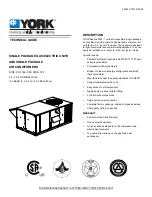
IOM-PreciseAIR
Page
8
of
50
2.5.
Storage
If required, store the equipment in a dry area, out of the weather, protected from damage by
other equipment in storage or transportation equipment. Never stack equipment and avoid
frequent relocation.
For split systems, the air handler section and compressor section are each shipped charged and
sealed with low pressure (1
–
5 psig) inert gas, such as nitrogen. This will prevent contaminants
from entering the coil. If the coils are not charged and sealed, condensation mixes with air
pollutants forming a weak acid and over time it can cause pinhole leaks to develop in the coil
tubes. If the equipment is stored longer than 30 days, the Customer should check that each
section is still charged to avoid coil damage.
Refer to the unit’s mechanical submitt
al.
Prior to long term storage, fan bearings and motor bearings are to be greased per the
manufacturer’s specifications. On belt driven blowers, the belt tension should be reduced to less
than half the specified value for the fan’s design to prevent a sa
g/set from forming in the shaft
and belts.
On a monthly interval, the blower should be checked to ensure that it has remained in an
acceptable stored condition. The blower and motors should be rotated several times by hand
while adding enough grease to replenish the bearing surfaces with fresh grease and to maintain
a full bearing cavity.
When equipment is installed after being stored, caution should be taken to inspect and replace,
if required, belts and gaskets. All moving parts, such as blowers and motors, should be hand tested
to ensure that they are free and clean prior to start-up. Finally verify that all lubrication is fresh
and full.
2.6.
Room Considerations
This unit is designed to control the room temperature within close tolerances. However, the room
must be built with a proper vapor barrier to prevent diffusion of moisture through wall, ceiling
and floor. Failure to provide a vapor barrier can compromise space conditions.
Proper room sealing is required to prevent excessive infiltration of humid air into the space. Unit
sizing must consider the impact of infiltration air or pressurization air on the sensible and latent
cooling load capacity required by the unit.
Unless the unit was specified to be installed outdoors by the Customer at the time of purchase,
the unit should be installed indoors or under a roof to protect from weather.
Содержание PreciseAIR PCA Series
Страница 15: ...IOM PreciseAIR Page 15 of 50 2 13 Main Control Panel Layout and Components Figure 4 Main Control Panel Layout...
Страница 27: ...IOM PreciseAIR Page 27 of 50 3 6 Setpoint Screens...
Страница 28: ...IOM PreciseAIR Page 28 of 50...
Страница 49: ...IOM PreciseAIR Page 49 of 50 4 11 Maintenance Logs...









































